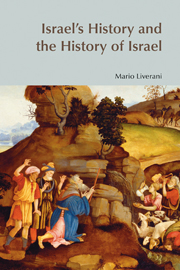Book contents
- Frontmatter
- Dedication
- Contents
- List of Tables and Illustrations
- Foreword
- Abbreviations
- IMPRINTING
- Part I A NORMAL HISTORY
- Chapter 2 THE TRANSITION (TWELFTH CENTURY)
- Chapter 3 THE NEW SOCIETY (c. 1150–1050)
- Chapter 4 THE FORMATIVE PROCESS (c. 1050–930)
- Chapter 5 THE KINGDOM OF ISRAEL (c. 930–740)
- Chapter 6 THE KINGDOM OF JUDAH (c. 930–720)
- Chapter 7 THE IMPACT OF THE ASSYRIAN EMPIRE (c. 740–640)
- Chapter 8 PAUSE BETWEEN TWO EMPIRES (c. 640–610)
- Chapter 9 THE IMPACT OF THE BABYLONIAN EMPIRE (c. 610–585)
- INTERMEZZO
- Part II AN INVENTED HISTORY
- EPILOGUE
- Bibliography
- Index of References
- Index of Names of Persons and Deities
- Index of Placenames
Chapter 2 - THE TRANSITION (TWELFTH CENTURY)
from Part I - A NORMAL HISTORY
- Frontmatter
- Dedication
- Contents
- List of Tables and Illustrations
- Foreword
- Abbreviations
- IMPRINTING
- Part I A NORMAL HISTORY
- Chapter 2 THE TRANSITION (TWELFTH CENTURY)
- Chapter 3 THE NEW SOCIETY (c. 1150–1050)
- Chapter 4 THE FORMATIVE PROCESS (c. 1050–930)
- Chapter 5 THE KINGDOM OF ISRAEL (c. 930–740)
- Chapter 6 THE KINGDOM OF JUDAH (c. 930–720)
- Chapter 7 THE IMPACT OF THE ASSYRIAN EMPIRE (c. 740–640)
- Chapter 8 PAUSE BETWEEN TWO EMPIRES (c. 640–610)
- Chapter 9 THE IMPACT OF THE BABYLONIAN EMPIRE (c. 610–585)
- INTERMEZZO
- Part II AN INVENTED HISTORY
- EPILOGUE
- Bibliography
- Index of References
- Index of Names of Persons and Deities
- Index of Placenames
Summary
A Multifactor Crisis
Whether positively or negatively influenced by the biblical narrative, modern scholars (archaeologists as well as biblical scholars) have suggested unequivocal yet strongly contrasting theories about Israel's origins. Even when properly understood as merely one feature in the huge epochal crisis of transition from Bronze Age to Iron Age, the case of Israel continued to receive special attention and more detailed explanation. The historical process has been reconstructed several times, and here it will be sufficient to recall the main theories suggested over the years. (1) The theory of a ‘military’ conquest, concentrated and destructive, inspired by the biblical account, is still asserted in some traditional circles (especially in United States and Israel), but today is considered marginal in scholarly discussion. (2) The idea of a progressive occupation, currently widespread in two variants that are more complementary than mutually exclusive: the settlement of pastoral groups already present in the area and infiltration from desert fringe zones. (3) Finally, the so-called ‘sociological’ theory of a revolt of farmers, which totally prioritizes a process of internal development without external influence; after initial consent during the 70s and 80s this has been less widely accepted, sometimes for overt political reasons. The different theories are usually set one against the other, yet all of them should be considered in creating a multifactored explanation, as required by a complex historical phenomenon.
- Type
- Chapter
- Information
- Israel's History and the History of Israel , pp. 32 - 51Publisher: Acumen PublishingPrint publication year: 2005



